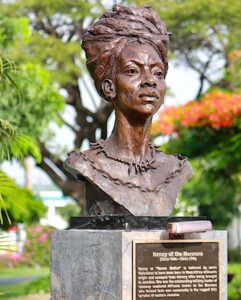Queen Nanny of the Maroons is a fascinating historical figure that has been celebrated in Jamaica for centuries.
Her story has had a significant influence on Jamaican culture and history because of her extraordinary bravery, leadership, and tenacity.
The life and legacy of Queen Nanny of the Maroons will be examined in this article as we delve into her story, her contributions to the Maroon community, and her enduring influence on Jamaican society.
In this post, we’ll go into great detail about Queen Nanny’s life, following her path from her beginnings in Ghana’s Ashanti area to her arrival in Jamaica as a slave.
We will explore how she became a leader in the Maroon community, using her knowledge of African herbal medicine, spirituality, and warfare to help them survive and resist their oppressors.
We will also focus on the Maroons specifically, looking at their background, way of life, and contributions to Jamaican civilization.
We’ll look at how they managed to preserve their freedom and independence in spite of huge disadvantages, being much outnumbered, and having inferior equipment.
Finally, we’ll talk about Queen Nanny’s legacy and historical and cultural effects on Jamaica. We will look at how her accomplishments have been honored and remembered through memorials, celebrations, and places of cultural significance.
Overall, this article will provide a comprehensive exploration of Queen Nanny of the Maroons and her enduring legacy, offering readers a deeper understanding of this fascinating historical figure and the impact she continues to have on Jamaican culture and society.
Early Life of Queen Nanny of the Maroons & Escape from Slavery
Legend has it that Queen Nanny of the Maroons was born around 1686 into the Akan people, located in present-day Ghana, West Africa.
She was a member of the Ashanti people, known for their fierce resistance to European colonization and the transatlantic slave trade. At the age of around 18, she was captured and taken to Jamaica as a slave.
Despite being forcibly taken from her homeland and separated from her family, Queen Nanny did not lose her spirit of resistance and resilience.
Along with a group of other enslaved Africans, she escaped from her plantation and fled to the mountains, where they formed a community of escaped slaves known as the Maroons.
Despite several versions of her early life story, it is uncertain which is factual. In one account, she arrived in Jamaica as a free woman who may have even owned her own slaves, while in another version, she was brought to Jamaica as a slave but managed to escape.
Leadership and Resistance
Nanny and her four brothers were sold into slavery and later escaped from their plantations to seek refuge in the mountains and jungles of Jamaica, which still make up a significant portion of the island.
Together with her brother Quao, Nanny founded Nanny Town, a village situated in the Blue Mountains on the Eastern side of Jamaica.
Nanny was renowned for her expertise in Obeah, which is a religious and magical practice that incorporates West African influences.
Obeah is a religion that originated in Africa and is still practiced in several Caribbean countries, including Jamaica, Trinidad and Tobago, and Barbados. It is associated with both good and bad magic, charms, luck, and mysticism in general.
According to Maroon oral history, Nanny’s ability to defend her people against colonial forces was often attributed to her mysterious supernatural powers.
It is believed that Nanny had magical abilities and could catch bullets, redirecting them back to the people who shot at her. This was a testament to her power, and many people were inspired by her bravery and resilience.
Another Maroon legend claims that if any white man goes to the original Nanny Town, he immediately dies.
This is a testament to the fearlessness and determination of Nanny and her followers to defend their freedom against their oppressors.
Nanny and her Maroon warriors were formidable opponents who refused to be intimidated by their colonizers. Instead, they used their unique cultural practices and spiritual beliefs to resist their oppressors and maintain their autonomy.
Queen Nanny quickly emerged as a leader among the Maroons, using her knowledge of African herbal medicine, spirituality, and warfare to help her people survive and resist their oppressors.
She is said to have been a skilled military strategist, leading successful raids against the British colonizers and their allies.
One of Queen Nanny’s most significant accomplishments was the creation of the Maroon Code, a set of laws and guidelines that governed the community and ensured its survival.
The code emphasized collective action, cooperation, and self-sufficiency, and was instrumental in enabling the Maroons to resist and evade British attempts to capture and enslave them.
Queen Nanny’s leadership and resistance had a significant impact on Jamaican history. She was a prominent figure in the First Maroon War, which took place circa 1728 to 1739.
The war was a struggle between the Maroons and the British colonizers, with the Maroons emerging victorious and securing their freedom and autonomy.
Nanny Town flourished under Nanny’s leadership and strategic planning. Being located in the mountains made it difficult for European settlers to attack, and Nanny preferred to farm and engage in peaceful trade with her neighbors rather than launch violent attacks on plantations and European settlements.
Nonetheless, she organized several raids to free slaves from plantations, leading to the escape of almost 1,000 slaves over the course of her lifetime.
However, Nanny’s success came at a cost. The British colonial administration became increasingly alarmed by the power of the Maroons and their ability to resist European authority.
Plantation owners, who suffered losses in terms of slaves and crops due to Maroon raids, demanded action from colonial authorities.
Thus, hunting parties comprising British soldiers, militiamen, and mercenaries scoured the Jamaican jungles.
Captain William Cuffee, also known as Captain Sambo, is credited with killing Nanny during one of the many bloody battles of the war.
The war itself lasted circa 1720 to 1739, with Cudjoe, one of Nanny’s brothers and a key Maroon leader, driving the peace negotiations that led to the truce.
The Maroons of Jamaica are descendants of West Africans, predominantly from the Akan people, known for their fierce fighting spirit.
It is believed that some of the enslaved were brought from other African regions such as Nigeria, the Congo, and Madagascar, although the origins of at least half of the enslaved Africans brought to Jamaica during the early English colonization are uncertain.
After being forcibly brought to Jamaica during the Transatlantic slave trade, many enslaved Africans escaped from the harsh conditions of plantations to form their own communities of free black people in the rugged and hilly interior of the island.
These communities, known as Maroons, were located in the mountains of eastern Jamaica and the Cockpit Country in the west.
Legacy and death of Queen Nanny of the Maroons
The Journal of the Assembly of Jamaica, dated 29-30 March 1733, contains a citation for “loyal slaves” who fought bravely in the First Maroon War.
These soldiers, under the command of Captain Sambo, included William Cuffee, who was praised for his bravery and rewarded for killing Nanny, the rebel’s old obeah woman.
However, it is doubtful that Cuffee actually killed the Nanny who led Nanny Town, as evidence shows that her leadership continued until her people were granted Moore Town in 1740.
Although the exact date of Queen Nanny’s death remains a mystery, some believe that she lived to be an old woman, dying of natural causes in the 1760s.
The title “Nanny” is an honorific given to high-ranking women in Maroon Town, but the Maroons insist that there was only one “Queen Nanny.”
Her remains are believed to be buried in Moore Town, at a site known as “Bump Grave,” according to Maroon’s oral history.
Queen Nanny’s contributions to Jamaica have been recognized by the government, which has bestowed upon her the title of “Right Excellent” and honored her as a National Hero.

She is the only woman among the seven National Heroes of Jamaica, and her description has been used to create a modern portrait that appears on the Jamaican $500 note, the largest banknote in circulation in Jamaica.
Conclusion
Queen Nanny’s legacy has had a profound impact on Jamaican culture and history. She is celebrated as a national hero, with statues, monuments, and cultural festivals commemorating her life and contributions.

Her story has also inspired generations of Jamaicans, particularly women and people of African descent, to fight for their rights, dignity, and liberation.
Queen Nanny’s influence can be seen in many aspects of Jamaican culture, from music and art to politics and social justice activism.
She has been cited as a source of inspiration by many Jamaican leaders, including Marcus Garvey, who saw her as a symbol of Black resistance and self-determination.
Queen Nanny of the Maroons was a remarkable leader and symbol of resistance, whose legacy continues to inspire and empower people around the world.
Also read: Cécile Fatiman, the Vodou Priestess Who Sparked the Haitian Revolution
Her unwavering commitment to freedom, justice, and self-determination is a testament to the human spirit and the enduring power of resilience in the face of oppression and adversity.
As we continue to fight for a more just and equitable world, we can look to Queen Nanny of the Maroons as a guiding light and source of inspiration for generations to come.
Following Nanny’s death, many Maroons migrated to the more sparsely inhabited Western side of Jamaica. Nanny Town was eventually captured and destroyed by the British in 1734.
Source
https://www.blackpast.org/global-african-history/queen-nanny-maroons-1733/
